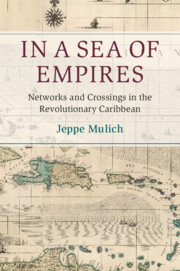Book contents
- In a Sea of Empires
- Cambridge Oceanic Histories
- In a Sea of Empires
- Copyright page
- Dedication
- Contents
- Figures
- Tables
- Acknowledgments
- 1 Introduction
- 2 Free Ports and Black Markets
- 3 Imperial Warfare, Colonial Violence
- 4 Prize Courts and Privateers
- 5 Slave Laws and Free Communities
- 6 Abolition and the Illegal Slave Trade
- Conclusion
- Bibliography
- Index
3 - Imperial Warfare, Colonial Violence
Published online by Cambridge University Press: 24 June 2020
- In a Sea of Empires
- Cambridge Oceanic Histories
- In a Sea of Empires
- Copyright page
- Dedication
- Contents
- Figures
- Tables
- Acknowledgments
- 1 Introduction
- 2 Free Ports and Black Markets
- 3 Imperial Warfare, Colonial Violence
- 4 Prize Courts and Privateers
- 5 Slave Laws and Free Communities
- 6 Abolition and the Illegal Slave Trade
- Conclusion
- Bibliography
- Index
Summary
While later chapters examine the institution of slavery through its legal framework and the dynamics of the slave trade, Chapter 3 looks at the way in which the fear of slave uprisings shaped the security complex of the islands and became a significant force for intercolonial integration. Although the microregion thus increasingly took on the state-like functions of an internal security guarantor, such practices did not completely supplant existing inter-imperial rivalries. Rather, these two dynamics – mutual security reliance and political rivalry over trade and territory – coexisted in an uneasy constellation, the balance between them often depending on the strength of local and imperial ties of centrally placed actors within the islands’ intercolonial networks. The first half of the chapter analyzes the mutual security networks of the Leeward Islands associated with slave revolts, while the second half explores inter-imperial warfare in the region, with a particular focus on the prolonged periods of military occupations of smaller islands by the British Empire in particular.
- Type
- Chapter
- Information
- In a Sea of EmpiresNetworks and Crossings in the Revolutionary Caribbean, pp. 58 - 80Publisher: Cambridge University PressPrint publication year: 2020
- 1
- Cited by

